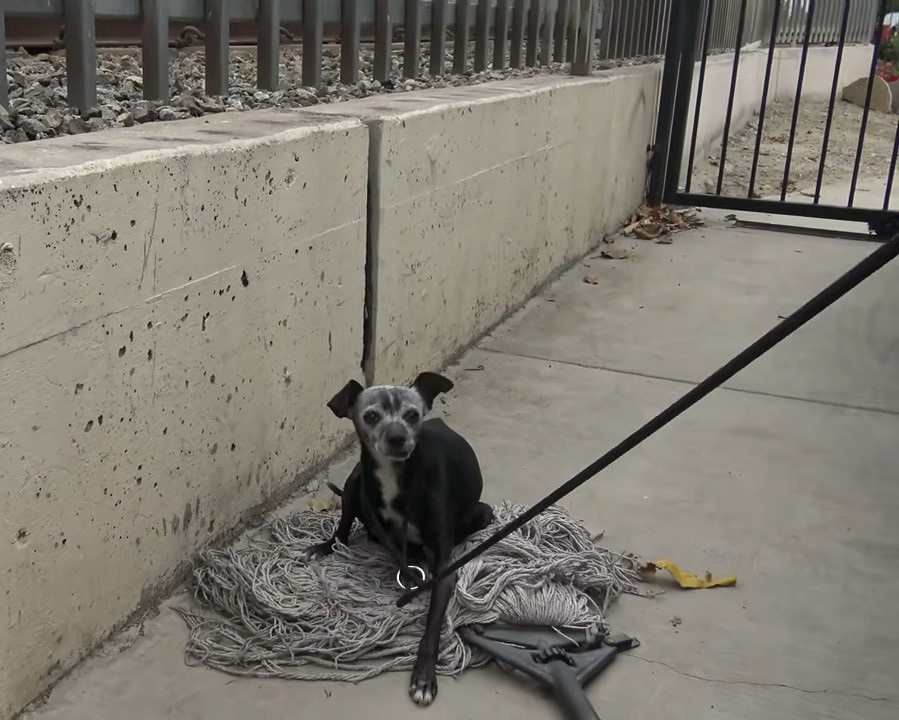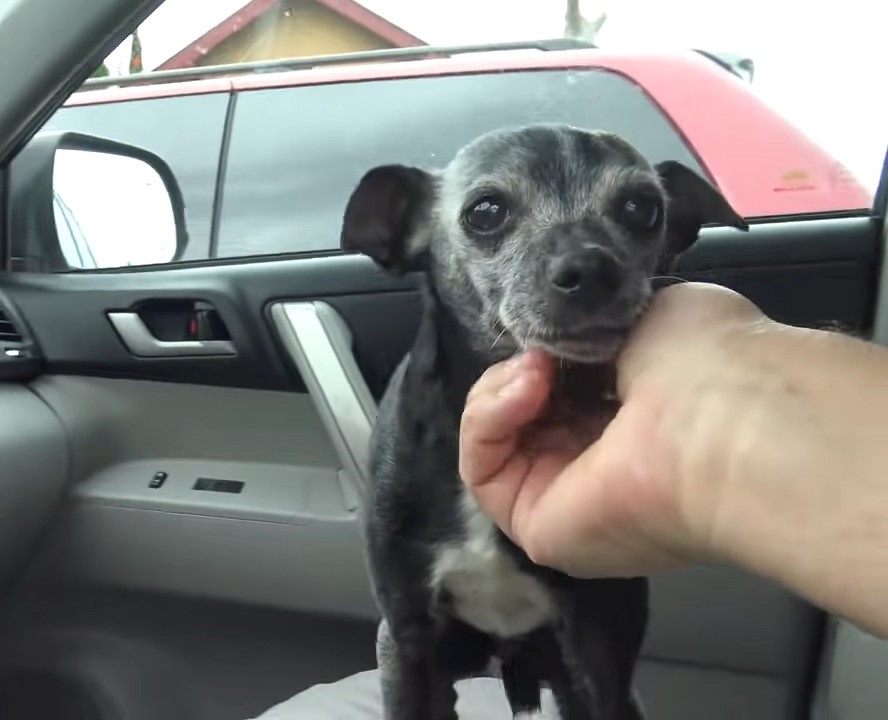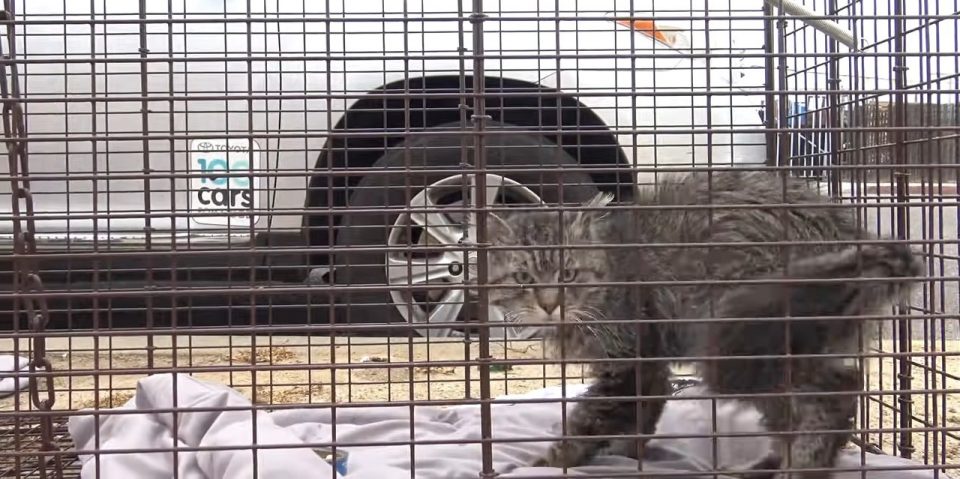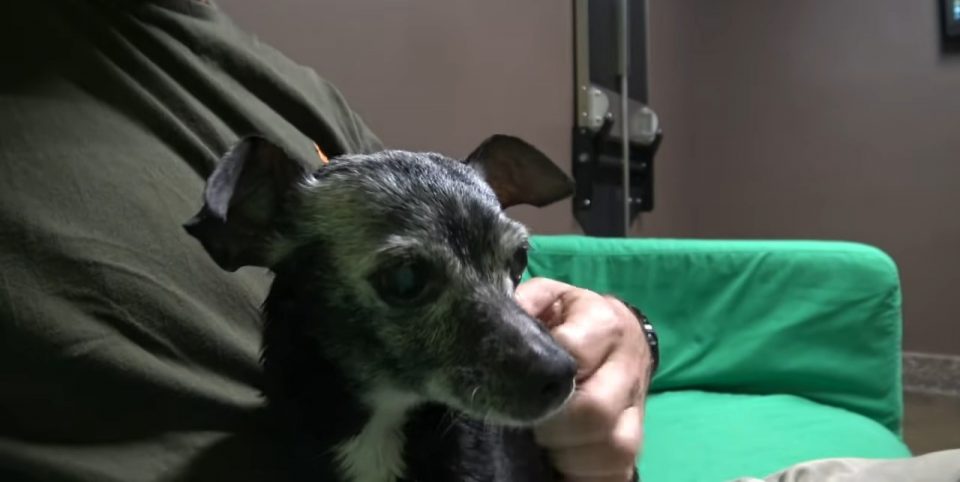Other than adopting dogs, there are many ways all of us could do more to help strays across the world find a shelter or a forever home.
A simple solution would be to help them by taking them to the nearest sanctuary where they can get help.
However, if that doesn’t work out, a simple phone call would suffice. The point is that there is always something you can do to help out an animal that needs you.
In this story, we will talk about a group of rescuers from California who found a stray dog in need and decided to give her a new chance to live her life.
She Was Lying On A Mop

When a group of rescuers working for Hope for Paws was notified by a homeowner about a senior stray dog living in his yard, they answered the call for help.
Apparently, the dog had been running on the road and was trying to dodge traffic. When she could no longer run, she collapsed in someone else’s yard.
The man allowed rescuers to enter his yard so they could try and help the dog. They realized that the space she was sleeping in was a little hard to reach.
So, they took a leash and tried placing it around her head. The dog, now named Pipa, was going to be taken to a shelter where she could get a new chance to start over.

After they secured her and started taking her to the car, they noticed that she was wagging her tail the whole time and was just happy to see that somebody cared for her.
Who really knows how long she had been surviving on her own, she never deserved to suffer so much and finally managed to catch a break.
Now that she was safe in the car, her rescuer received a call about another mission that required his attention, so he decided that Pipa was going to tag along with him.
A Double Rescue

Once they were in the area, the man noticed a stray cat that needed his help. Considering that he came a bit unprepared, he had to improvise this rescue.
He gave her some food and noticed that she went for it, even though she was a bit afraid to approach him.
She was so hungry that she didn’t care if the rescuer placed her in a kennel with food. The cat willingly went in and was now heading for the shelter in California.
The two briefly met in the car, but they separated later when they finally reached their destination. They were both given a warm bubble bath so they could get rid of all the germs.

Pipa just relaxed completely in the care of the shelter workers and had absolute faith that they would be there for her.
You can just tell easily that she still had faith in other people, which was a good sign that she would recover.
However, she had an underlying spine injury and had to be hospitalized because of it.
Soon after her treatment was over, she was taken to a foster home with Lionel’s Legacy where they would work diligently to find Pipa a new home.
While we don’t have any updated information on what happened to the dog and the cat, I have no doubt that the amazing rescuers at Hope for Paws found them a forever home.
If you’ve ever found yourself puzzled by your furry friend’s sudden lack of interest in mealtime, you’re not alone. As a seasoned dog trainer, I’ve seen this scenario play out countless times. A dog’s refusal to eat can be concerning, leaving you wondering what could be causing this behavior. It’s essential to understand that several factors, both physical and emotional, can influence your dog’s appetite.
When your pup turns their nose up at their food bowl, it can be frustrating and worrisome. From changes in routine to underlying health issues, there’s a myriad of reasons why your dog may be exhibiting this behavior. As we delve into the possible explanations behind your dog’s reluctance to eat, remember that patience and observation are key in deciphering the root cause of this common canine conundrum.
Understanding the Problem: Why Won’t My Dog Eat?
Common Reasons for Loss of Appetite in Dogs
Dogs may refuse to eat due to various reasons. Dental issues like toothache or gum disease can make chewing painful for your furry friend. Infections, digestive problems, or even medications can also affect their appetite. Stress and anxiety, changes in routine, or issues with the food itself can lead to a loss of interest in eating.
When to Be Concerned About Your Dog Not Eating
It’s normal for dogs to skip a meal occasionally. However, if your dog consistently refuses food for more than 24 hours, it’s time to be concerned. Prolonged lack of appetite can lead to serious health issues. Look for other signs like lethargy, vomiting, or diarrhea. If you notice these symptoms, it’s crucial to consult a veterinarian promptly to identify and address the underlying cause.
Health-Related Causes of Anorexia in Dogs
Dental Problems and Oral Pain
If your dog is avoiding eating, dental issues might be the culprit. Just like humans, dogs can suffer from dental problems like gum disease, fractured teeth, or infections. Oral pain can make it uncomfortable for your furry friend to chew their food, leading to a decreased appetite. Check for signs of bad breath, bleeding gums, or difficulty while eating.
Underlying Diseases and Illnesses
Anorexia in dogs can also be a sign of underlying health conditions. Diseases such as kidney disease, liver problems, or infections like parvovirus can cause a dog to lose interest in food. If your dog’s eating habits change suddenly, it might be wise to consult with your veterinarian to rule out any serious illnesses and provide appropriate treatment.
The Impact of Age on a Dog’s Eating Habits
As dogs age, their nutritional needs and eating habits may change. Older dogs are more prone to conditions like arthritis, dental issues, or organ dysfunction, which can affect their appetite. Additionally, senior dogs may experience a decrease in the sense of smell or taste, making food less appealing. Adjusting their diet to meet their changing needs and providing softer, more palatable food options can help encourage them to eat.
Behavioral and Environmental Factors
Stress, Anxiety, and Depression
Stress, anxiety, and depression aren’t just human emotions; your furry companion can experience them too. If your dog is feeling stressed due to loud noises, a recent move, or being left alone for extended periods, it could lead to a loss of appetite. Similarly, if your pup is feeling anxious or sad, they may not be interested in their food.
Changes in Environment or Routine
Dogs thrive on routine, so any sudden changes in their environment or daily schedule can throw them off. Whether it’s a new home, a new family member, or even a change in feeding times, your dog may struggle to adjust. These disruptions can affect their eating habits, causing them to skip meals or eat less than usual.
Remember, understanding your dog’s behavior and addressing any potential stressors or changes in routine can play a vital role in helping them regain their appetite.
Nutritional Issues and Food Preferences
The Role of Diet Quality and Food Allergies
When your dog refuses to eat, it could be due to the type of food you’re offering. Just like humans, dogs have preferences, and they may not like the taste or texture of certain foods. Make sure you’re providing high-quality food that is both nutritious and palatable. Check if your dog has any food allergies that could be causing them to avoid their meals. Allergies can lead to digestive issues and discomfort, so it’s essential to address them by switching to hypoallergenic options.
Finding the Right Balance: Palatability vs. Nutrition
Balancing palatability and nutrition is crucial in ensuring that your dog eats well and stays healthy. While it’s important to offer food that your dog enjoys eating, you must also consider the nutritional value of the diet. Look for well-balanced meals that meet your dog’s dietary requirements while also appealing to their taste buds. You can consult your vet for recommendations on specialized diets that are both nutritious and tasty to help entice your dog to eat. Remember, a balanced diet is key to keeping your furry friend happy and healthy.
Consulting a Veterinarian
What to Expect During the Veterinary Visit
When you take your dog to the vet for not eating, the veterinarian will conduct a thorough examination to determine the underlying cause. They may ask you questions about your dog’s eating habits, recent behavior changes, and medical history. Be prepared to provide detailed information to help the vet make an accurate diagnosis.
During the visit, the vet will likely examine your dog’s mouth for any dental issues, check for signs of infections, and assess overall health. They may also feel for any abnormalities in the abdomen or other areas. Based on the initial assessment, the vet may recommend further tests or procedures to identify the specific reason for your dog’s lack of appetite.
Diagnostic Tests and Procedures
To pinpoint the cause of your dog’s eating problems, the veterinarian may recommend various diagnostic tests and procedures. These may include blood tests to check for underlying health conditions, such as liver or kidney problems, and to assess organ function. Urine tests can also provide valuable information about your dog’s overall health status.
In some cases, the vet may suggest imaging techniques like X-rays or ultrasounds to examine internal organs for any abnormalities. These tests can help detect issues that may not be apparent during a physical examination alone. Additionally, fecal tests may be necessary to rule out parasites or gastrointestinal issues that could be affecting your dog’s appetite.
Depending on the findings, the veterinarian will create a treatment plan tailored to your dog’s specific condition. This plan may include medication, dietary changes, or further monitoring to ensure your furry friend gets back to their healthy, happy self. Consulting a veterinarian is crucial when your dog refuses to eat to address the root cause promptly and effectively.
Home Care and Expert Tips
Tips for Encouraging Your Dog to Eat
When your dog doesn’t want to eat, try these tips to stimulate their appetite:
- Warm Meals: Serve warm food to enhance the aroma and make it more appealing.
- Variety in Diet: Offer a variety of foods to entice your dog and prevent boredom.
- Regular Feeding Schedule: Stick to a consistent feeding routine to establish eating habits.
- Interactive Feeders: Use interactive toys or gadgets that dispense food to make mealtime fun.
- Hand Feeding: Sometimes hand feeding can encourage your dog to eat, especially if they are feeling unwell.
Safe Human Foods to Stimulate Appetite
If your dog is being fussy, you can try offering safe human foods in moderation to stimulate their appetite:
- Cooked Chicken: Plain, cooked chicken without seasoning or bones can be enticing.
- Pumpkin: Plain canned pumpkin (not pie filling) is a good source of fiber for digestion.
- Carrots: Raw or cooked carrots are crunchy and low in calories, making them a healthy snack.
- Plain Rice: Cooked plain rice can be soothing for your dog’s stomach.
- Sweet Potato: Baked sweet potato without any seasoning is a nutritious option.
Remember, always consult with your vet before introducing new foods to your dog’s diet to ensure they are safe and appropriate.
Conclusion
So, there you have it – a rundown on why your furry friend might be turning their nose up at mealtime. Whether it’s dental issues, stress, health concerns, or just picky eating habits, it’s essential to keep an eye on their appetite and seek advice from a vet if things aren’t improving. Remember, a few tweaks to their diet, some enticing mealtime strategies, and maybe a little help from safe human foods could be the key to getting them back on track. Tailored treatment plans and regular check-ups are crucial for addressing any underlying issues promptly. Your pup’s well-being is a top priority, so stay vigilant, be patient, and let’s get those tails wagging at mealtime again!
Frequently Asked Questions
Why is my dog not eating?
There are various reasons why your dog may not be eating, including dental issues, infections, stress, and food problems. It is essential to monitor your dog’s appetite and consult a vet if the issue persists.
What health-related causes could be impacting my dog’s eating habits?
Dental pain, underlying diseases, and age-related challenges in older dogs could affect your dog’s eating habits. Adjusting their diet according to their needs may help improve their appetite.
How can I encourage my dog to eat?
You can encourage your dog to eat by serving warm meals, offering a variety of foods, maintaining a regular feeding schedule, using interactive feeders, and hand feeding them. Safe human foods like cooked chicken, pumpkin, carrots, plain rice, and sweet potato can also stimulate their appetite.
What should I do if my dog continues to have eating issues?
If your dog continues to have eating issues, it is crucial to consult a vet for a thorough evaluation. Tailored treatment plans involving medication and dietary changes based on diagnostic tests may be necessary to address the root cause promptly and effectively.
[no_toc]

Hey there, I’m Janet Brooks, a dog-loving student from California. I’m all about helping pups in need, especially those without homes. Me and my awesome friends work together to give shelter and love to stray dogs. Oh, and I also write blogs about dogs to share helpful info.